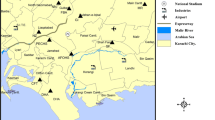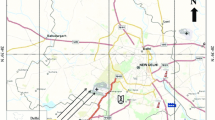Abstract
Dew water and rainwater samples collected during winter season from an urban environment of Delhi, India were alkaline in nature with an average pH of 6.78 ± 0.47 and 5.91 ± 1.14, respectively. The concentrations of all soluble ions except NO3 − were considerably high in dew compared to rainwater. Nitrite was exceptionally high in dew water (dew/rainwater ratio = 11.7). The direct emissions of NO2 and production of NO2 (from NO3 and NO reaction during daytime) are responsible for high NO2. The direct gas to liquid exchange and/or dissolution HONO through heterogeneous chemistry could concentrate nitrite in dew during nighttime. The alkaline pH of dew water could also favor HONO formation. However, more detailed work is needed to spell out the reasons/processes for high nitrite in dew. NH4 + ions, formed from NH3 solubility in dew water, cation (Ca2+ and Mg2+) rich fine aerosols play a dominant role in the acidity neutralization and the final pH of dew water. Neutralization factors (NFs) followed the order NFNH4 + > NFCa 2+ > NFMg 2+ in the dew and rainwater but the absolute values of NFs were higher in dew. In the dew water, Ca2+ and K+ are contributed by crustal sources, SO4 2− and NO3 − by anthropogenic, and Mg2+ and Cl− by sea salt. Mg2+ and Cl− are also contributed by sea salt (27 %) and anthropogenic (66 %) sources, respectively. The sources remain the same for rainwater but their contributions vary depending on the ionic species. The differences in the dew and rainwater composition are linked to (1) dew formation takes place within the mixing layer enriched with pollutants on account of temperature inversions in the study area, (2) atmospheric gases-aerosols-water interactions during dew formation in winters, and (3) the heterogeneous chemistry. In the absence of the neutralizing cations, dew water containing high acid forming ions could be potentially harmful to buildings, plants, and water bodies in this region.


Similar content being viewed by others
References
Acker K, Febo A, Trick S, Perrino C, Bruno P, Wiesen P, Möller D, Wieprecht W, Auel R, Giusto M, Geyer A, Platt U, Allegrini I (2006) Nitrous acid in the urban area of Rome. Atmos Environ 40:3123–3133
Acker K, Beysens D, Möller D (2008) Nitrite in dew fog cloud and rain water: an indicator for heterogeneous processes on surfaces. Atmos Res 87:200–212
Agam N, Berliner PR (2006) Dew formation and water vapor adsorption in semi-arid environments—a review. J Arid Environ 65:572–590
Ali K, Momin GA, Tiwari S, Safai PD, Chate DM, Rao PSP (2004) Fog and precipitation chemistry at Delhi, North India. Atmos Environ 38:4215–4222
Beysens D (1995) The formation of dew. Atmos Res 39:215–237
Beysens D, Milimouk I, Nikolayev V, Muselli M, Marcillat J (2003) Using radiative cooling to condense atmospheric vapor: a study to improve water yield. J Hydrol 276:1–11
Beysens D, Ohayon C, Muselli M, Clus O (2006) Chemical and biological characteristics of dew and rain water in an urban coastal area (Bordeaux France). Atmos Environ 40:3710–3723
Bouwman AF, Lee DS, Asman WAH, Dentener FJ, Van Der Hoek KW, Olivier JGJ (1997) A global high resolution emission inventory for ammonia. Glob Biogeochem Cycles 11:561–587
Das N, Das R, Chaudhury GR, Das SN (2010) Chemical composition of precipitation at background level. Atmos Res 95:108–113
Foster JR, Pribush RA, Carter BH (1990) The chemistry of dews and frosts in Indianapolis, Indiana. Atmos Environ 24:2229–2236
He Y, Zhou X, Hou J, Gao H, Bertman S (2006) Importance of dew in controlling the air surface exchange of HONO in rural forested environments. Geophysical Research Lettersdoi:10.1029/2005GL024348.
Jacobs AFG, Heusinkveld BG, Berkowicz S (2000) Dew measurements along a longitudinal sand dune transect, Negev desert, Israel. Int J Biometeorol 43:184–190
Jiries A (2001) Chemical composition of dew in Amman, Jordan. Atmos Res 57:261–268
Keene WC, Pszenny AAP, Galloway JN, Hawley ME (1986) Sea-salt corrections and interpretation of constituent ratios in marine precipitation. J Geophys Res 91:6647–6658
Khare P, Singh SP, Kumari MK, Kumar A, Srivastava SS (2000) Characterisation of weak organic acids in dew collected on surrogated surfaces. J Atmos Chem 37:231–244
Kleffmann J, Becker KH, Wiesen P (1998) Heterogeneous NO2 conversion processes on acid surface: possible atmospheric implications. Atmos Environ 32:2721–2729
Kumar P, Yadav S (2013) Factors and sources influencing ionic composition of atmospheric condensate during winter season in lower troposphere over Delhi, India. Environ Monit Assess 185:2795–2805
Lakhani A, Parmar RS, Prakash S (2012) Chemical composition of dew resulting from radiative cooling at a semi-arid site in Agra, India. Pure Appl Geophys 169:859–871
Lekouch I, Mileta M, Muselli M, Milimouk-Melnytchouk I, Šojat V, Kabbachi B, Beysens D (2010) Comparative chemical analysis of dew and rain water. Atmos Res 95:224–234
Lu X, Li LY, Li N, Yang G, Luo D, Chen J (2011) Chemical characteristics of spring water of Xian city NW China. Atmos Environ 45:5058–5063
Mulawa PA, Cadle SH, Lipari F, Ang CC, Vandervennet RT (1986) Urban dew: its composition and influence on dry deposition rates. Atmos Environ 20:1389–1396
Muselli M, Beyens D, Soyeux E (2006) Is dew water potable? Chemical and biological analyses of dew water in Ajaccio (Corsica island, France). J Environ Qual 35:1812–1817
Nilsson T (1996) Initial experiments on dew collection in Sweden and Tanzania. Sol Energy Mater Sol Cells 40:23–32
Ortiz V, Rubio MA, Lissi E (2000) Hydrogen peroxide deposition and decomposition in rain and dew waters. Atmos Environ 34:1139–1146
Parashar DC, Kulshrestha UC, Jain M (2001) Precipitation and aerosol studies in India. Environ Monit Assess 66:47–61
Pathak AK, Yadav S, Kumar P, Kumar R (2013) Source apportionment and spatial–temporal variations in the metal content of surface dust collected from an industrial area adjoining Delhi, India. Sci Total Environ 443:662–672
Rondon A, Sanhueza E (1989) High HONO atmospheric concentrations during vegetation burning in the tropical savannah. Tellus 41 B: 474–477
Rubio MA, Lissi E, Villena G (2002) Nitrite in rain and dew in Santiago city, Chile. Its possible impact on the early morning start of the photochemical smog. Atmos Environ 36:293–297
Rubio MA, Lissi E, Villena G (2008) Factors determining the concentration of nitrite in dew from Santiago, Chile. Atmos Environ 42:7651–7656
Rubio MA, Lissi E, Villena G, Elshorbany YF, Kleffmann J, Kurtenbach R, Wiesen P (2009) Simultaneous measurements of formaldehyde and nitrous acid in dews and gas phase in the atmosphere of Santiago, Chile. Atmos Environ 43(38):6106–6109
Sharan G, Beysens D, Milimouk I (2007) A study of dew water yields on galvanized iron roof in Kothara (North-West India). J Arid Environ 69:259–269
Singh SP, Khare P, Kumari KM, Srivastava SS (2006) Chemical characterization of dew at a regional representative site of North-Central India. Atmos Res 80:239–249
Subrananiam AR, Rao KAVR (1983) Dew fall in sand dune areas of India. Int J Biometeorol 27:271–280
Takenaka N, Soda H, Sato K, Terada H, Suzue T, Bandow H, Maeda Y (2003) Difference in amounts and composition of dew from different types of dew collectors. Water Air Soil Pollut 147:51–60
Takenaka N, Suzue T, Ohira K, Morikawa T, Bandow H, Maeda Y (1999) Natural denitrification in drying process of dew. Environ Sci Technol 33:1444–1447
Takeuchi M, Okochi H, Igawa M (2000) A study on chemical components and acidification mechanism of dew-water. J Jpn Soc Atmos Environ 35:158–169
Takeuchi M, Okochi H, Igawa M (2003) Deposition of coarse soil particles and ambient gaseous components dominating dew water chemistry. J Geophys Res. doi:10.1029/2002JD003058
Tandon A, Yadav S, Attri AK (2008) City wide sweeping a source for respirable particulate matter in the atmosphere. Atmos Environ 42:1064–1069
Tandon A, Yadav S, Attri AK (2010) Coupling between meteorological factors and ambient aerosol load. Atmos Environ 44(9):1237–1243
Taylor SR, McLennan SH (1985) The Continental Crust: Its Composition and Evolution. Blackwell Oxford 312 pp.
Wagner GH, Steele KF, Peden ME (1992) Dew and frost chemistry at a mid-continent site United States. J Geophys Res 97:20591–20597
Yadav S, Rajamani V (2004) Geochemistry of aerosols of Northwestern Part of India adjoining the Thar Desert. Geochim Cosmochim Acta 68:1975–1988
Yadav S, Rajamani V (2006) Air quality and trace metal chemistry of different size fractions of aerosols in N–NW India—implications for source diversity. Atmos Environ 40:698–712
Acknowledgments
Pawan is thankful to the council of scientific and industrial research (CSIR) India for junior research fellowship during this work. Grants received under the Department of Science and Technology, Government of India, New Delhi-Promotion of University Research and Scientific Excellence (DST-PURSE-JNU) by SY and utilized in this work are duly acknowledged.
Author information
Authors and Affiliations
Corresponding author
Electronic supplementary material
Below is the link to the electronic supplementary material.
Supplementary Table AT1
(DOC 68 kb)
Supplementary Table AT2
(DOC 38 kb)
Rights and permissions
About this article
Cite this article
Yadav, S., Kumar, P. Pollutant scavenging in dew water collected from an urban environment and related implications. Air Qual Atmos Health 7, 559–566 (2014). https://doi.org/10.1007/s11869-014-0258-7
Received:
Accepted:
Published:
Issue Date:
DOI: https://doi.org/10.1007/s11869-014-0258-7




